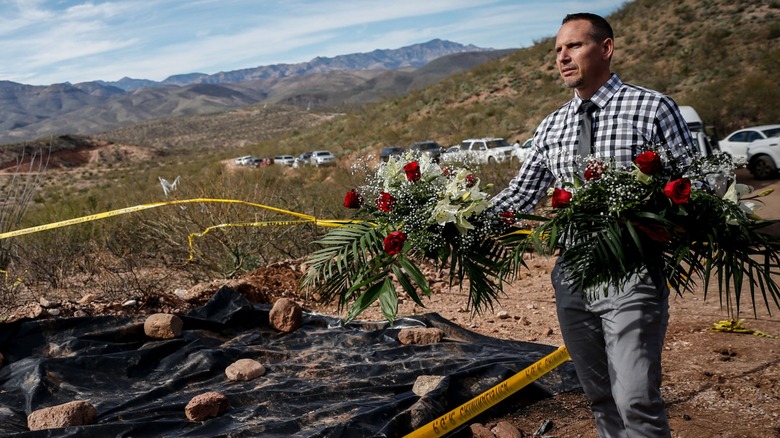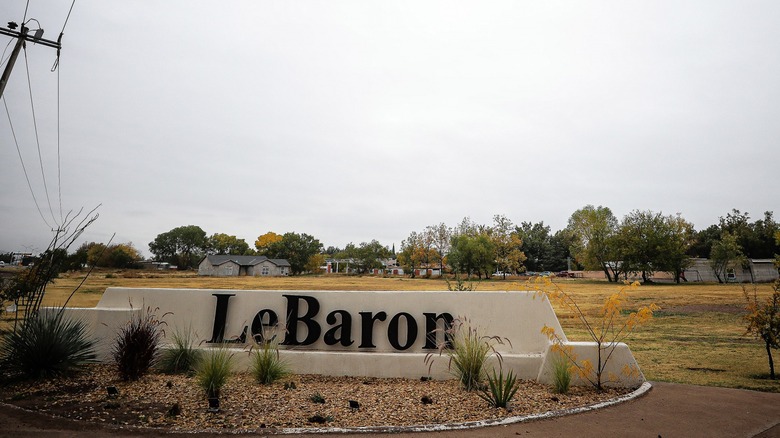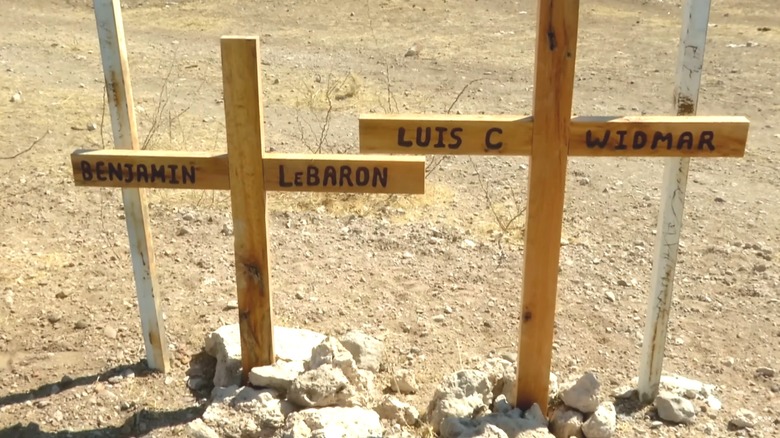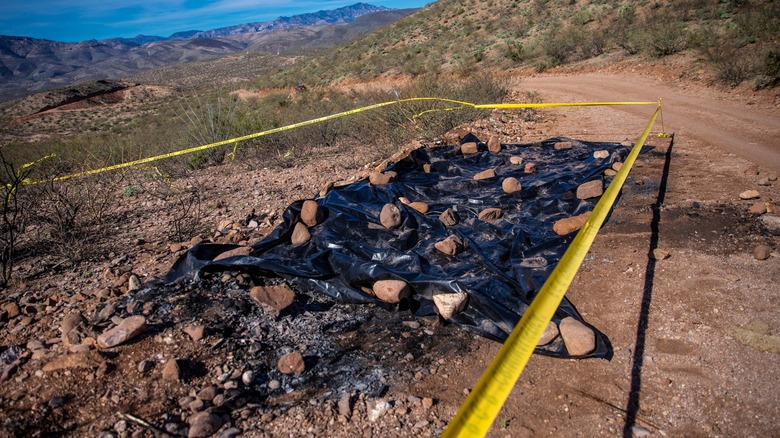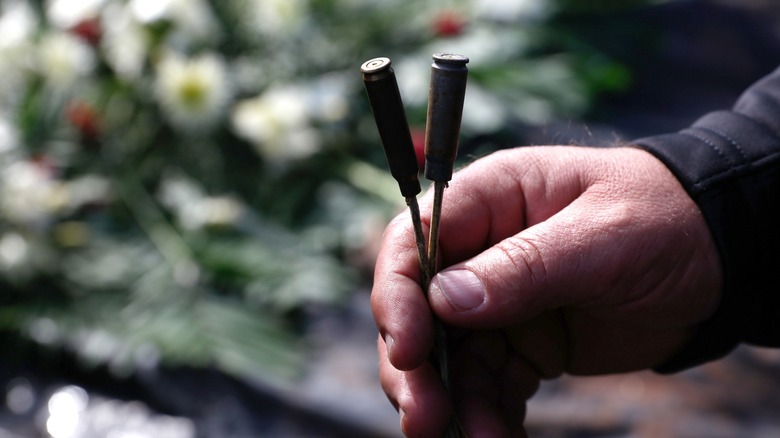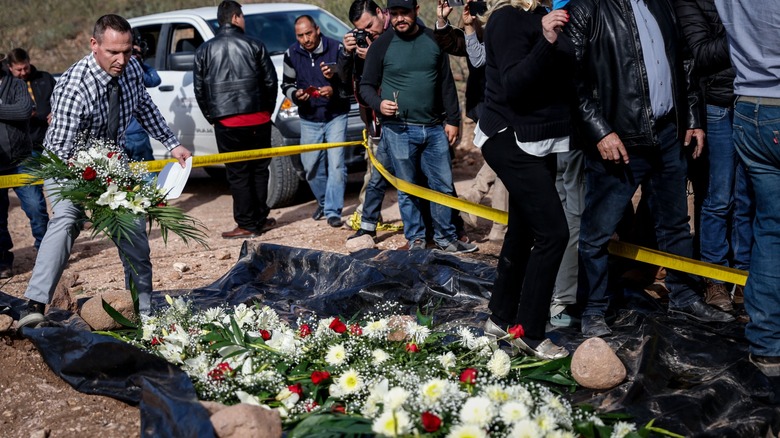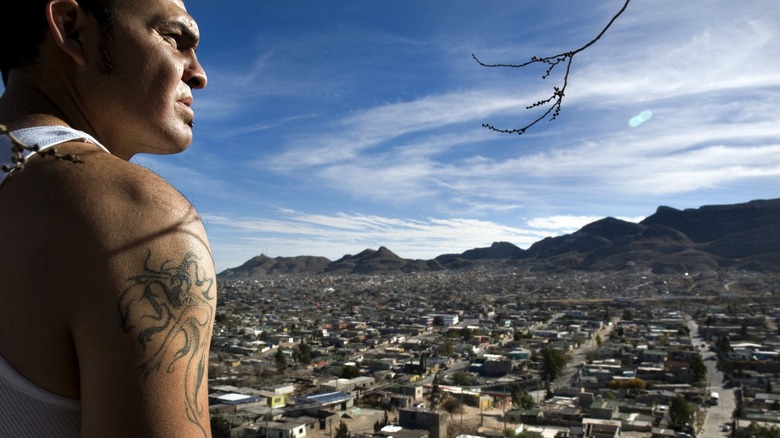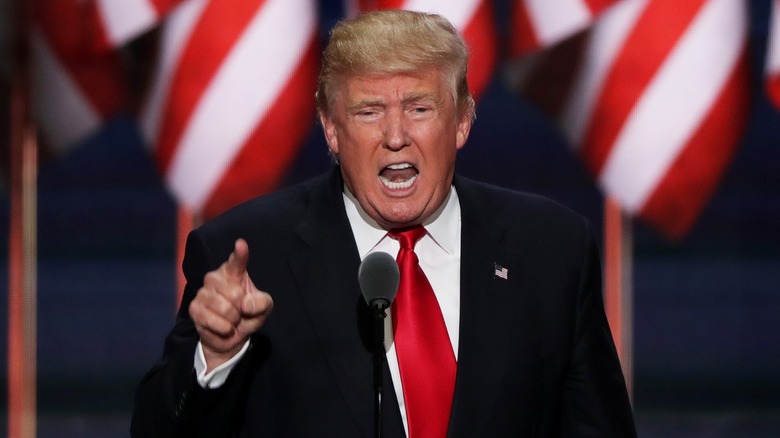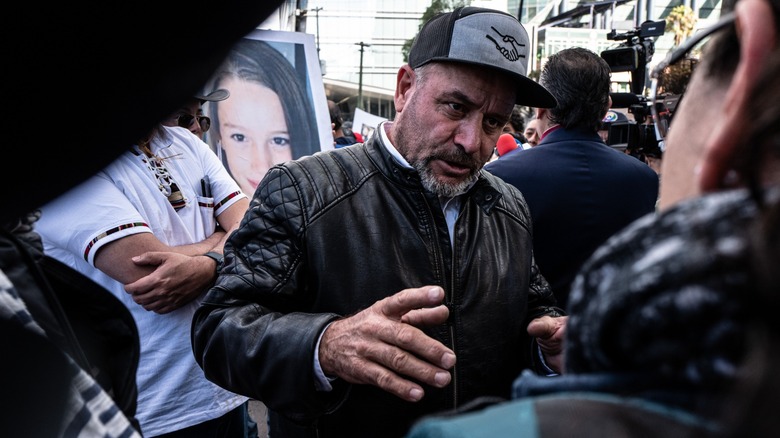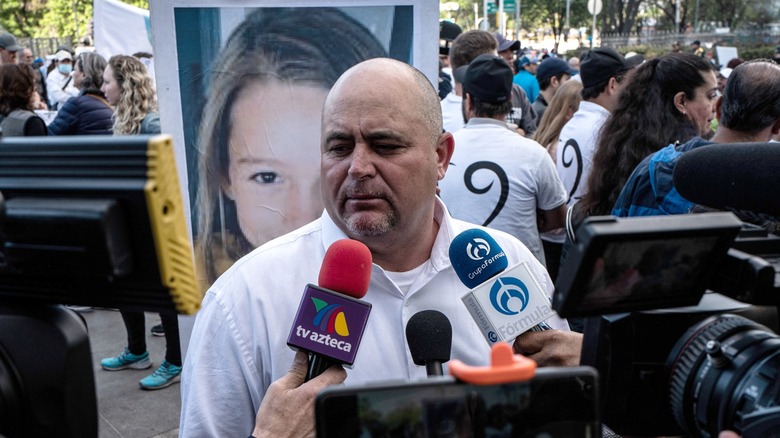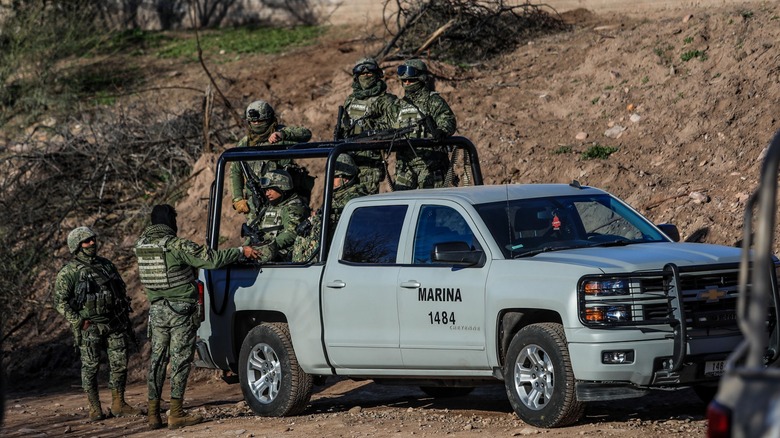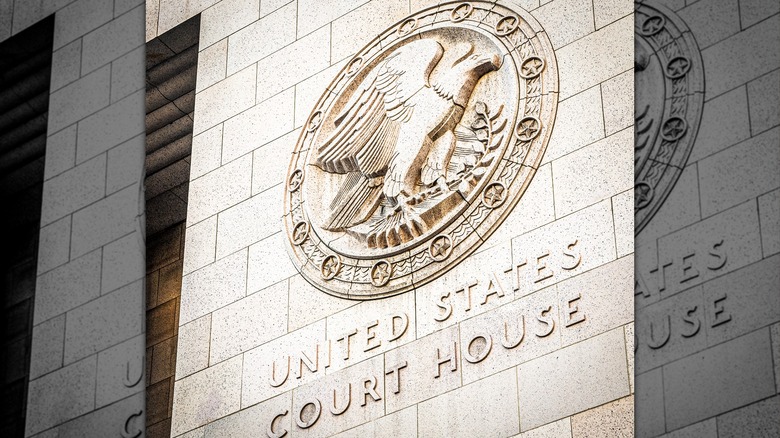The Grim 2019 Massacre Of A Mormon Community In La Mora, Mexico
On November 4, 2019, the lives of the LeBarón family were forever changed. That morning, nine members of the family were brutally massacred in a gangland-style killing in La Mora, in the Mexican State of Sonora, and the victims included six children and three women. It's suspected that the perpetrators were members of the La Línea criminal organization, who themselves are part of the larger Juarez Cartel — one of the deadliest drug trafficking groups in the world. Chillingly, La Línea is thought to be composed of police officers who are hired by the cartel, some of whom are allegedly still active in law enforcement.
It's still disputed why the cartel targeted the LeBaróns, the descendants of whom were originally from the United States but emigrated away to Mexico in the 1920s, seeking religious freedom. The family was at one point affiliated with the Church of Jesus Christ of Latter-day Saints, but were later excommunicated and founded the Church of the Firstborn of the Fulness of Time, an LDS offshoot.
Most of the family are dual American and Mexican citizens, and they spend their time in both places. The massacre was not the first instance of cartel violence associated with the family, but it was by far the most deadly. Today, several years after the massacre, no one has been charged or convicted of any wrongdoing relating to the killings, and the case is still considered open by authorities.
The LeBarón family's tumultuous history
The LeBarón family's story dates back over a century to the late 1800s. At the time, polygamy was considered acceptable in the Church of Jesus Christ of Latter-day Saints, until 1890, when the church officially outlawed it as part of their push to make Utah a state. This upset many practicing Mormons, causing countless of them to flee south to Mexico to avoid being prosecuted under U.S. law.
One of those families was the LeBaróns, which included Alma Dayer LeBaron. The LeBaróns briefly returned to Utah following the upheaval of the Mexican Revolution, but Alma and his family made their way back in 1924 for good. Ostracized from the new community over his continued adherence to polygamy, Alma founded a new colony, Colonia LeBarón, in 1944, but died a few years later in 1951. In 1955, his son, Joel LeBarón, founded a new church, the Church of the Firstborn of the Fulness of Times, a fundamentalist offshoot of the larger LDS church. However, in 1971, there was a split between Joel and his brother Ervil LeBarón, leading to Ervil's excommunication.
In response, Ervil had Joel murdered, and, along with his family, was implicated in at least 40 more killings, including Ervil's own pregnant daughter Rebecca. Ervil would eventually be convicted of murder and die in prison in 1981, but that was far from the end of the LeBarón's story.
The 2009 LeBarón kidnappings and murders
When Alma Dayer LeBarón founded Colonia LeBarón in 1944, there was no way he could have anticipated that the surrounding area would later become the contested purview of dangerous drug traffickers. Yet, by the mid-2000s, the violence in Mexico related to illicit drug trafficking had exploded, and starting around 2008, some of the traffickers began to target the colony for extortion. This culminated in the May 2009 kidnapping of Eric LeBarón, a 16-year-old family member who was held for $1 million in ransom.
In response, family members protested against the Mexican government, and Eric was thankfully released without harm. However, the family's protests brought the ire of vicious Juarez Cartel boss Jose "El Rikin" Escajeda, who happened to live very close to the family's colony in Mexico. A few months later, the narcos struck again. This time, they took Benjamin LeBarón and his brother-in-law, Luis Widmar. Benjamin was an outspoken critic against the narcos, and the kidnappers brutally murdered both him and Widmar, before leaving their bodies to be found on the side of the road.
Nobody was ever held responsible for the killings, and the scene is marked today with a small wooden memorial installed by family members of the victims. Benjamin's brother Julian LeBarón has continued his brother's legacy of anti-narco activism, which hasn't exactly earned him a lot of friends in the cartels.
A wedding in Chihuahua
On November 4, 2019, 17 members of the extended LeBarón family set out from La Mora, located in the Mexican state of Sonora, to head towards Colonia LeBarón in neighboring Chihuahua. There were three women, all of them related to each other, and 14 of their kids in the caravan. The occasion was a wedding at Colonia LeBarón between Kendra Lee Miller and Zach Loub, relatives of the families.
The three mothers, Rhonita LeBarón Miller, Christina Langford Johnson, and Dawna Ray Langford, were planning on making the majority of the trip together, though Miller was supposed to later break off from the caravan and head north to meet her husband. The Millers — who were cousins before getting married as teenagers — were living in North Dakota at the time, but had recently planned on moving to La Mora. They had seven children together, four of whom were in Miller's SUV when she headed out. In Johnson's SUV, it was just her and her young daughter Faith, who was not even a year old, and the final SUV, driven by Langford, had nine of her 13 children in tow.
The trip to Colonia LeBarón was only supposed to take about six hours, and though they were familiar with the road, the route was far from safe and littered with deadly narcos. Just minutes into the trip, Miller experienced serious car troubles, but that would turn out to be the least of their worries.
The first attack
Already wary about making the dangerous trek from La Mora to Colonia LeBarón, after just five miles in, the caravan experienced their first problems. The SUV that Rhonita LeBarón Miller was driving broke down, leading the entire group to turn around and acquire new transportation for her and her children. After setting back out, Miller stopped by her broken-down SUV to retrieve a few things, before racing to catch back up with her relatives down the road in front of her.
However, around 10:00 a.m., before she had a chance to reach them, Miller and her family were attacked. Cartel gunmen killed Miller and all four of her kids, leaving their bodies to burn in the wreckage on the side of the road. One of Miller's relatives was on their way to tow her Suburban back home when he came upon the attack, after which he fled home — the family viewed the wreckage on a drone before heading to the scene.
Along with the family were members of the Sonora Cartel, local drug traffickers who were on ambiguous but largely peaceful terms with the family, and at war with La Línea — the soon-to-be alleged perpetrators. When the family arrived at the scene, they found the Miller's SUV still on fire, with the burned and mutilated bodies inside. Immediately, panic set in about the remainder of the caravan down the road, but it was already too late.
The second massacre
Shortly after attacking the SUV carrying Rhonita LeBarón Miller and her four children, the cartel members set their sights on the remainder of the caravan 11 miles up the road. The first car in the caravan was driven by Christina Langford Johnson, with Dawna Langford trailing her from behind. The gunmen struck at Johnson's SUV first, killing her as she got out of her car and pleaded for mercy.
When Dawna arrived at the scene, she saw the carnage and immediately knew there was serious trouble. She tried to protect and warn her kids to get down, but the cartel's firepower was too great. Almost instantly, Dawna and two of her sons were killed in the melee of gunfire that blasted through the SUV.
In just under an hour, cartel members had taken the lives of nine members of the extended LeBarón family: three women and six children. Their relatives scrambled to rush to the crime scene and find out what happened, but before they could, they ran into another astonishing site: one of the passengers, 13-year-old Devin, who had walked six hours from the massacre.
Only kids survived
Caught up in the horrific violence of the LeBarón family massacre were the 14 children riding with their parents. Inside Rhonita LeBarón Miller's car were four of her seven children; two eight-month-old twins and their older brother and sister. Tragically, all four of them were killed in the attack. Inside Christina Langford Johnson's car was her seven-month-old daughter Faith, who incredibly managed to survive the shootout but was almost struck by a bullet herself. Faith was found in the car hours later, while her slain mother lay just outside, covered in bullet holes.
In the final car was Dawna Langford with nine of her children. Two of them were killed in the shootout, but the other seven managed to survive. Miraculously, after the initial hail of gunfire, a member of the cartel found the still-living children inside the SUV and allowed them to leave. Five of them had suffered gunshot wounds, and they hid out in nearby bushes after realizing they were too injured to make the trip back together.
The oldest boy in the group, Devin Langford, started walking back towards the family's residences in La Mora. Six hours later, he ran into the family out searching for the crime scene, and told them about the horrible incident. The group was thankfully able to locate all six of the remaining children, though they urgently needed medical attention.
No one knows for sure why they were attacked
When news of the massacre first leaked, authorities and the press immediately started speculating about who the killers were and why they had targeted the unarmed and innocent caravan. Mexican authorities initially put the blame on the Sinaloa Cartel, before later backtracking and instead blaming their rivals in the Juarez Cartel. The theory was that the family members were accidental victims, who were in the wrong place at the wrong time when the cartels started shooting at each other.
This was contradicted a few days later by other authorities in the Mexican government, who now claimed that Rhonita LeBarón Miller was deliberately murdered due to her anti-narco activism. The authorities still blamed the cartels, but also suggested that the family's deaths could have been tied to ongoing land disputes between them and their neighbors, which had recently turned violent.
For their part, most of the family thinks that the massacres were no accident. Many of them believe that the cartels deliberately targeted the family, but which one killed them and why is still in heavy dispute. Some in the family think it was the Juarez Cartel's enforcement arm, La Línea, but others outside the family insist it was the Sinaloa Cartel. Even today, there is no clear picture of who perpetrated the killings and why the family was killed, though many, including DEA informants, consider the attack to have been deliberate and intentional.
President Trump chimed in
Due to the dual Mexican-American citizenship of the victims of the massacre, the incident was almost guaranteed to make waves north of the border, in the United States. Almost immediately, U.S. President Donald Trump got on X (formerly known as Twitter) to vent his anger at the situation. Somewhat wrongly characterizing the families as being from Utah, Trump repeated the initial narrative about the families being caught up in a cartel gun battle, a story that was later shown to most likely be wrong.
Trump would go as far as to offer the use of U.S. military troops to invade Mexico and wipe out the cartels, which Mexican President Andrés Manuel López Obrador hastily rejected as being an inappropriate response. Due to the former U.S. president's rhetoric about Mexico, which often bordered on racism in many people's eyes, it was little surprise he would offer such a bold take on the situation, and he wasn't the only one. Other U.S. Republican Senators also spoke out on the issue, and the LeBaróns took things into their own hands by lobbying several senators directly, too.
Trump threatened to designate all cartels as terrorist groups, which some saw as a pretext for him to launch military strikes into Mexico. He ended up backing down, but that did not stop the family from continuing to lobby, and soon their protests would become much more public.
The March for Truth, Justice, and Peace
From the beginning, many members of the LeBarón family were upset with how the authorities handled the investigation into the deaths of their loved ones. Their frustrations started when the family members managed to beat authorities to the initial crime scenes, and they immediately started collecting evidence to give to U.S., not Mexican, law enforcement. A few months after the massacre, in January 2020, several family members took their anger at the lack of progress in the investigation to the streets, when they organized a massive protest to take place at the capitol in Mexico City.
The protest, called the "March for Truth, Justice, and Peace," not only consisted of hundreds of LeBarón family members, but also people from all over Mexico who were also affected by the cartel violence. During the protest, Adrián LeBarón (pictured above), the father of Rhonita LeBarón Miller, one of the victims, made a brief speech and received support from many of those in attendance.
However, not everyone was on board with the LeBarón's protests. In addition to the protestors marching against the government, there were also counterprotestors rallying against the LeBaróns. Many of them were resentful that the LeBaróns had any land in Mexican territory, and some may even have begun to get physical by pushing family members at the march.
Another near attack in February
A few months after the massacre, family member Julian LeBarón, an anti-narco activist, found himself in a very dangerous situation. After continuing to speak out about the lack of police response to the massacre, the cartels decided to strike back. First, they had a shootout near Colonia LeBarón on February 17, 2020, but they may have been planning something much more personal.
The next day, LeBarón was at his house in the colony when he got a phone call from a friend that gave him an ominous warning. The caller told LeBarón that members of La Línea were potentially targeting him, that he was not safe in his home, and he needed to leave — fast. While cartel gunmen gathered in a canal just blocks from his home, LeBarón called law enforcement for help. Previously, LeBarón had called the local police for information about the February 17 shooting, but they had hung up on him, so this time he called the federales for protection.
LeBarón claimed that the local police were in bed with the cartels, and it was Mexican federal police who helped him escape to the United States unharmed. LeBarón wasn't the only family member to leave La Mora in the aftermath of the attack, as hundreds of families had already fled the area following the November murders, afraid of reprisals like the kind LeBarón had just experienced.
Still no convictions
Barely a day after the massacre occurred on November 4, 2019, authorities already had their first arrest and lead on the killers. Federal police took a man into custody at the U.S.-Mexican border, who had footage on his cell phone showing that the gunmen had not only deliberately torched the SUV belonging to Rhonita LeBarón Miller, but had also executed one of the young boys who was trying to run away.
Less than a month after the killings, on December 1, 2019, Mexican authorities announced that they had taken even more suspects into custody, but they did not give any details about who they were. Later that month, authorities said that they had arrested a local police chief, giving credence to the family's complaints that the police were working hand-in-hand with the cartel.
Within a year a dozen suspects had been arrested, and in September 2023, U.S. authorities announced the arrest of a Mexican national in New Mexico who was related to the case. However, even with all the arrests, there has been little progress towards an outcome. As of November 2023, four years after the murder, authorities have not charged anyone with the murders, much less gotten any convictions.
A $4.6 billion symbolic victory
In July 2020, nine months after the tragic massacre at La Mora, several members of the LeBarón family filed a lawsuit against the Juarez Cartel in U.S. federal court. The lawsuit alleged the cartels engaged in terrorism and murder, and more than 20 family members joined in on the litigation. The family was basing the lawsuit on the Anti-Terrorism Act, and are thought to be the first to use the act against a cartel.
Three years later, the family was awarded a massive judgment against the cartel. Originally, the court ruled they would get $1.5 billion, but due to the act's language, the amount was then tripled to a stunning $4.6 billion.
Unfortunately, the lawsuit and the verdict are largely an empty achievement. As one might expect, the cartel did not have anyone speak on their behalf at the trial, leaving the families nobody specific to direct their anger at, and there is essentially no way for them to collect the damages. Still, the verdict was a symbolic victory, and it may be the only closure the family ever gets.
